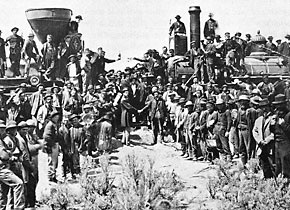Growth of the Railroad
Railroad tracks were laid across the East and Midwest prior to the Civil War, but goods and travelers could only ride as far as Omaha, Nebraska. Since the business of America needed to continue while the Civil War was being fought, President Lincoln signed the Pacific Railroad Act in 1862 to build the Transcontinental Railroad. Goods and travelers would be able to travel from New York to California in ten days.

Railroad Brochure
The transcontinental track that began in Sacramento, California and traveled eastward was built by the Central Pacific Railroad Company, owned by Leland Stanford. The track that began in Omaha, Nebraska and traveled westward was built by the Union Pacific Railroad Company, which was owned by Thomas Durant. Both companies were private entities, but each received government subsidies that equaled 64,000 acres of land for the tracks and $48,000 in government bonds per mile of track laid. The building of the Transcontinental Railroad continued through President Grant’s administration.

Map and location of the Transcontinental Railroad
Historians have generally called the building of the Transcontinental Railroad a race. Since the meeting point was not set prior to the signing of the Pacific Railroad Act, Stanford and Durant wanted to earn as much of the subsidy funds as possible. Government subsidies and cheap labor made it possible for Stanford and Durant to become very rich men. Both sets of tracks finally met in Promontory Point, Utah on May 10, 1869.

Promontory Point, Utah
Chinese immigrants were not new to America. Many had traveled to California during the Gold Rush. Stanford sent ships to China, however, to transport over 6,000 immigrant workers to labor on the Central Pacific track. In a statement made by Leland Stanford to the President of the United States and the Secretary of the Interior on the progress of the work, Chinese laborers are described as “quiet, peaceable, patient, industrious and economical—ready and apt to learn all the different kinds of work required in railroad building, they soon become as efficient as white laborers. More prudent and economical, they are contented with less wages.”